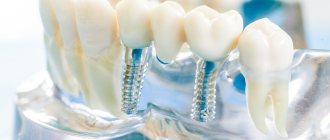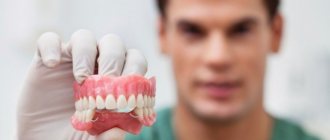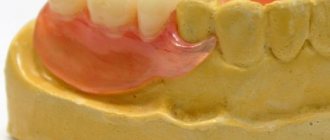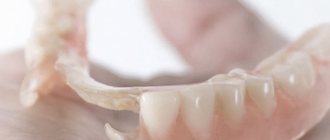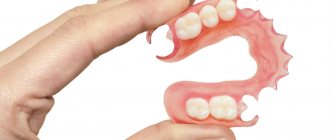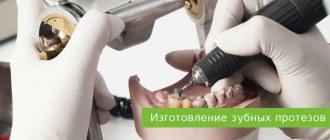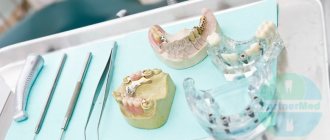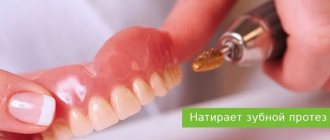The loss of even one tooth in a row can lead to serious negative consequences for the health of the oral cavity as a whole, so it is necessary to solve the problem and restore lost dental units immediately. To restore lost teeth, modern dentistry offers different types of procedures - prosthetics and implantation. The greatest demand among patients is for more affordable prosthetics, which can involve both fixed and removable types of dentures.
In terms of durability and strength of fixation, the best option would be fixed dentures, but their installation is not always possible, and then removable dentures can help restore the beauty of your smile. However, such orthodontic structures are available in a wide range, and sometimes the patient finds it difficult to choose a specific type of product for prosthetics. This article is designed to help you find out all the useful details about removable dentures, and we will start with a detailed overview of all existing types of removable dentures.
Removable dentures: definition and classification
Orthodontic products for prosthetics can be either removable or non-removable. The key difference between the designs is that by choosing a removable denture, you can always either remove or put it on without the help of a specialist. Removable dentures have their own gradation into individual varieties, which is important to get acquainted with - this will help you make the right choice of a specific type of product. First of all, you should know that there are separate types of removable dentures for complete and single restoration.
What types of designs are there for restoring lost teeth?
Dentures are structures used to replace natural human teeth. They allow you to completely restore the anatomy and physiology of the dentofacial apparatus. The advantage of installing dentures is that a person can replace either one tooth or an entire row. This will immediately have a positive effect on the appearance of your smile, and the modern approach to creating a prosthesis allows you to restore the functioning of the device almost perfectly.
The following options for orthopedic prosthetics and rehabilitation exist:
Installation of removable structures
This type of prosthesis is a fixation of structures that the patient can independently remove and put on. They are completely removable and are used in cases of complete absence of teeth; usually, they are the most popular option for temporary prosthetics. Conditionally removable structures are also used, which are tightly attached with locks to the remaining teeth and partially distribute the load on them.
Fixation of fixed dentures
Such structures are firmly fixed to the jaw and function in the same way as regular teeth. They are not removed, and cleaning the prosthesis does not require additional manipulations. In modern dentistry, it is fixed structures, in particular implantation, that are more in demand and physiological. These are any crowns or bridge structures.
Microprosthetics
Such prosthetics are the most modern and involve the use of special inlays: veneers, lumineers, metal-free pins. This also includes adhesive or cable-stayed prosthetics. These structures have been used relatively recently, but have already gained popularity in the dental market due to their good aesthetic appearance and fixation on natural teeth without changes in the distribution of loads on the jaw.
Your dentist will help you determine which dentures are best to use in a particular situation. He will help the patient choose the optimal prosthetic option, based on his clinical situation and financial capabilities. In general, if you choose between a removable denture or implantation, then the most physiological and reliable method, of course, is implantation followed by the installation of crowns.
Dentures for restoration with complete edentia
Complete restoration of the dentition is necessary when all teeth have been lost and a complete removable denture is used for it, which allows you to effectively solve the problem of tooth loss, but keep in mind that such designs do not differ in reliability and long useful life, and especially the so-called soft orthodontic products - from plastic or nylon.
The rapid wear of the prosthesis is explained by the fact that with a complete restoration it is not possible to achieve coordinated work of the masticatory muscles: the main pressure will be exerted on the mucous and gingival part of the oral cavity and cause a decrease in the natural volume of the tissues of the jaw joint. As a result of this effect, the height of the gums will gradually decrease, and this process will ultimately lead to the fact that the old prosthesis simply will not stay on the installation bed. Moreover, the incorrect position of the removable denture in the mouth will provoke manifestations of pain when eating or actively talking.
Full removable orthodontic products are not the best option for restoring lost teeth because they cannot be properly fixed in the oral cavity and, especially, in the lower jaw area. Even the use of special adhesive gels will not give you a guarantee that the removable denture will not fall out of its place at the most inopportune moment. In such cases, dentists advise not to save money and initially carry out restoration with removable dentures on implants, which we will discuss in detail below.
USEFUL FACT: Removable dentures do not stop the process of bone tissue atrophy and, on the contrary, accelerate its progress. As the bone volume decreases, the denture will no longer stay in place and will require replacement. This is another reason why it is recommended to replace a removable orthopedic structure with a non-removable product as quickly as possible.
Removable dentures for partial dentures
If the patient has preserved teeth in the rows and these units are absolutely healthy, for restoration it is optimal to select one of the existing types of removable orthodontic systems for partial dentures.
In partial prosthetics, dentists use structures equipped with a special type of fastener - clasps. At their core, clasps are miniature locks that are attached to the jaw. The elements are made from fairly strong metal wire, which guarantees reliable fixation of the removable denture.
It is important to understand that partial dentures are only possible if there are units in the dentition that can be used as support for the installation of a removable denture. Another important nuance that must be taken into account when selecting a prosthesis for restoration with a single edentia is that not all types of structures are aesthetic in appearance and therefore they are not recommended for installation in the smile area.
Classification of removable dentures in dentistry is also carried out according to the material of their production. The material used to make an orthodontic product is one of the key criteria for the proper selection of a removable denture, since such important indicators as the comfort of use of the structure, its reliability and durability depend on it. Below we will consider in detail all types of removable dentures based on the material used.
Cost of removable structures
Each removable denture is custom-made to precisely fit the anatomical features of the mouth and jaw. Its cost depends on the complexity of production and the selected materials.
Plastic and acrylic types of prostheses are very popular with patients, as they are the least expensive for patients. Nylon and clasp varieties are much more expensive. Moreover, for the quality of such work, neither price nor size has any advantages, since all removable dentures are a temporary solution and are not suitable for all patients. In any case, each type of removable prosthesis is inferior to a fixed prosthesis in terms of functional and external characteristics.
Plastic or acrylic removable dentures
Acrylic or plastic removable dentures are inexpensive and easy to manufacture and use. For their production, a special type of acrylic plastic is used, characterized by increased characteristics of strength, hygiene and hypoallergenicity. The product is fixed to the jaw with soft valves, which are more colloquially referred to as “suction cups”. Naturally, the quality of fixation leaves much to be desired - the soft fastening element does not ensure reliable adhesion of the structure and tissues of the oral cavity.
If you have chosen a removable prosthesis with valves, be sure to make sure of the quality of its manufacture. This can be done using a simple test: having installed the denture in your mouth, try to bite something with it. If you feel air escaping from under the removable denture, it means it is made with high quality and will be comfortable to use.
An acrylic prosthesis will not cause pain during use if its base fits tightly to the gums. Otherwise, the chewing load will be placed on the soft tissues, which will cause a process of gradual atrophy and then deformation of the orthodontic structure itself.
Expert advice: Order the production of an acrylic removable denture with an individual impression tray - this will guarantee a tight fit of the structure to the tissues of the jaw and ensure its most reliable fixation on the jaw.
The advantages of removable acrylic dentures include the following qualities:
- The design is manufactured quickly and simply, which makes its cost as affordable as possible for patients.
- Acrylic removable dentures are easily repaired and restored if broken or damaged.
However, acrylic products also have a number of disadvantages, which are important to study before choosing this type of removable dentures. Professionals call the main disadvantage of plastic structures the fact that when installed in the oral cavity, the base of a removable denture will block the palate and this often causes such undesirable consequences as diction disorders and a decrease in the natural sensitivity of taste buds.
Removable acrylic dentures cannot be used for prosthetics in the lower jaw area, since there is no way to firmly fix the structure on the gums. Without reliable fixation, there is a risk that the prosthesis will fall out during eating or active dialogue. Inexpensive removable dentures made of acrylic do not differ in durability. The product will have to be replaced with a new one every two to three years, since plastic is a material prone to deformation. The useful life of a removable acrylic prosthesis may be shorter in situations where the process of reducing the volume of bone tissue in a patient occurs at an accelerated pace.
If we talk about the exact cost of the service for the manufacture and installation of a plastic prosthesis, it will depend on the type of product and the need for additional procedures before prosthetics. You can get a detailed consultation on removable prosthetics at any time convenient for you at our dentistry in Moscow - VENSTOM (located next to the Baumanskaya metro station).
Removable dentures made of nylon in Moscow
Another budget option for orthodontic structures for removable prosthetics are removable nylon dentures. Already from the name of the products it is clear that they are made from nylon - a soft polyamide with increased elasticity. This type of construction is applicable in both complete and single prosthetics. In the production of removable dentures, biocompatible and hypoallergenic nylon is used, which does not change color and properties under the influence of various external aggressive factors.
Dental nylon has a non-porous structure, which prevents the penetration of pathogenic microorganisms into the prosthesis. This quality distinguishes removable nylon dentures from products made of acrylic and other types of plastic. Nylon structures are fixed to the gums, where the base of the removable denture is fixed with special locks. Fastening elements are also made of nylon (less commonly, silicone) and therefore they remain inconspicuous against the background of the natural tissues of the oral cavity. Nylon clasps help to obtain the tightest possible fit of the removable denture to the bed, which is necessary for reliable fixation of the product in the mouth.
Among the advantages of removable dentures made of nylon are the comfortable anatomical shape of the products, compact size and low weight. These characteristics facilitate the process of adaptation to the design and reduce the risk of pain during the use of a removable denture. But orthodontic products made of nylon have not only advantages, but also a significant number of disadvantages:
1. A removable nylon denture does not provide coordinated work of the masticatory muscles and therefore excessive pressure occurs in the oral cavity on the soft tissues and mucous membranes. Constant loads on soft tissues and jaws accelerate the process of receding gums and reducing the volume of bone tissue.
2. Increased flexibility of the design leads to the fact that some of its elements will work more when chewing food, while others will work less. The result of uneven load is the patient’s discomfort while eating and fairly rapid wear of the removable denture.
3. Over time, the removable nylon denture sags and this phenomenon is fraught with inflammation in the oral cavity.
4. The surface of the product is rough and therefore plaque accumulates on the prosthesis, stone is formed, and an unpleasant odor may appear from the mouth.
Also, the disadvantages of removable dentures made of nylon include the significant time consumption for manufacturing the structure and the need for frequent and regular visits to the dentist for hygienic procedures to sanitize the denture base and the oral cavity.
Which removable dentures are better – acrylic or nylon? Comparison of designs and reviews from experts
What type of dentures is better - nylon or acrylic? Patients often turn to dentists with this question, finding it difficult to make a choice on their own. The answer to this pressing question will depend on in which area of the oral cavity restoration is required and what kind of restoration it will be - complete or partial.
If it is necessary to carry out prosthetics with complete edentia, then it is more advisable to opt for acrylic removable dentures - they stay in the oral cavity better due to the “suction cup” effect. But nylon and acrylic removable dentures are equally poorly suited for restoration in the area of the lower jaw bone - the products simply cannot be firmly fixed in this area. Therefore, here it is best to consider a fundamentally different type of structure - clasp dentures or dentures on implants. Nylon prostheses are inferior to plastic structures in terms of ease of use and durability. When using them, patients are more often concerned about painful relationships, and the care of a soft polyamide prosthesis requires more complex and specific care.
However, removable dentures made of acrylic are not suitable for the restoration of lost dental units with single prosthetics. The clasps of the prosthesis will be clearly visible, which can cause psychological discomfort to the patient. Therefore, for single dental prosthetics in the smile zone, preference is given to clasp or nylon products. Do you want to know more about plastic and nylon removable dentures and make the right choice of denture design? Sign up for a consultation with specialists at our clinic in Moscow – Vanstom! We are located next to the Baumanskaya metro station!
What are conditionally removable prosthetic models?
Partially removable structures are prostheses that the patient cannot remove on his own, but a specialist is able to remove or replace them. They are used for complete or partially edentulous teeth and have two main types of fastening:
- With the help of implants. The implants themselves can be normal standard root-shaped with a lifetime guarantee or thin basal or other mini-implants that are used for atrophic phenomena of the bone for undemanding patients. In general, root-shaped implants and similar designs make it possible to firmly fix the prosthesis on the jaw and achieve its complete immobility and functionality. and attached to the thickness of the alveolar process of the jaw. This will not happen with basal implants or mini-implants, since this is a temporary implantation.
- If the edentia is incomplete or the patient has age-related contraindications to implantation, then the dentures are attached to their own remaining teeth. The structure is glued to adjacent teeth using special materials, for example, a cementitious composition. The reliability of fixation in such situations is much less, and the service life is shorter.
Deciding which prosthesis is better in case of complete absence of teeth is quite simple: using a digital diagnostic model. Since implants allow you to adequately distribute the load across the jaw evenly and without errors, and with their help it is possible to include absolutely any geometry of the new dentition into the treatment plan, such digital prototyping of the treatment result will allow you to immediately understand at what points and how many implants are needed. With implantation, the prognosis for the future is much more honest, since bone resorption stops forever, chewing function is fully restored, and the dentition can never be distinguished from the present.
Dental dentures “Acry-free”
Innovative removable dentures are “Acry-free” dentures. These are elastic and flexible products made from unique raw materials based on acrylic resin. Acrylic gives the finished structure the necessary strength, rigidity and ensures its durability during operation.
Acri-Free removable dentures are often confused with products made of nylon or plastic, but this is a mistake: the designs have individual quality characteristics and are also easy to restore if the system breaks down. The material for making removable dentures Acry-free is biocompatible with the tissues of the oral cavity and is identical in color to the shade of the gums, which makes the finished structure aesthetic and invisible to others.
Choosing Acri-Free removable dentures is advisable if you have the following indications:
- An individual allergic reaction in a patient to metal alloys and plastic.
- The loss of both one tooth and the complete loss of dental units in rows.
- Periodontitis and periodontal disease. Installing a removable denture for this pathology will help prevent the process of further loosening of the teeth.
- Acri-Free soft prostheses are recommended for people whose professional activities are associated with an increased risk of injury.
Removable dentures of this type are valued by professionals for a significant number of advantages. In particular, the system may be used in prosthetics in cases where the patient has serious gum disease. Acri-Free structures are firmly fixed in the mouth, easy to repair, and the material they are made of does not cause allergic reactions or irritation of sensitive tissues of the oral cavity.
The advantage of Acri-Free is its excellent indicator of the tight fit of the products to the prosthetic bed, which eliminates the manifestation of pain when eating and helps to ensure proper functioning of the masticatory muscles. To install the system, it is not necessary to pre-file healthy teeth, and the prosthesis itself does not sag, does not absorb moisture, and pathogenic bacteria and foreign substances that can stain or damage the product do not penetrate into it. The structures do not require specific and labor-intensive care, their cost is lower than that of nylon removable dentures and, if desired, you can leave the denture on at night.
The only disadvantage of Akri-Free removable dentures is that their constant use will lead to gradual atrophy of bone tissue. But this disadvantage is characteristic of all types of systems used in removable prosthetics.
Options for fixed dentures
In modern dentistry, structures that are firmly fixed to the teeth and have more advantages than removable ones. But they also come in different types, and in order to decide which fixed dentures are better, you need to study in detail the characteristics of all options.
Crowns
This design follows the anatomical structure of the tooth and is placed on top of the damaged tissue, stopping further destruction and protecting the remaining tooth for the future. They can also be fixed on implants - artificial roots that are made of titanium and attached to the jaw bone tissue. Implantation with prosthetic crowns is considered the best way to restore the dentition, since the load on the jaw is completely preserved. The combination of different implants and crowns offered by different clinics is chaotic and takes time to understand the difference in products.
Crowns are of the following types, depending on the material of manufacture:
- Metal. Durable designs with good functionality. They used to be made of steel, dental alloys, and sometimes gold was used. The service life of such crowns is very high, as is their wear resistance. However, crowns are so unpredictable in the area of the neck of the tooth, where unnoticeable damage can occur, that it is very difficult to recommend them except temporarily for orthodontics; the teeth underneath them deteriorate. As an aesthetic solution, it is doubtful; they are too different from natural teeth. Previously, they were recommended to be placed on distant, almost invisible teeth.
- Metal-ceramic. Crowns differ from the previous version in that ceramic material is applied on top of them, which is matched to the color of natural teeth. This eliminates the disadvantage of poor aesthetics while maintaining the advantages of conventional metal crowns. To carry out such prosthetics, it is necessary to depulp healthy teeth. Sometimes there is an allergy to the alloy of the crown frame; a common reaction is “blue discoloration at the gums or a gray neck of the tooth.
- Ceramic. The safest designs, as they are guaranteed not to cause allergic reactions. At first glance, crowns are indistinguishable from real teeth. However, ceramic structures are characterized by increased fragility, so they were previously placed on the front teeth for aesthetic purposes and excluded from the bite. Very fragile, warranty no more than 12 months, not produced in our clinic.
- Zirconium. Zirconium dioxide crowns and veneers are lightweight, durable and invisible products that can be placed on any tooth. The main disadvantage is the cost. They have high biological compatibility with gums and never cause allergies.
- Lithium disilicate and aluminum silicate. A very worthy alternative to the previous option, no less durable and capable of withstanding maximum loads. Guarantees as for zirconium dioxide, with higher transparency of the workpiece. The technology, less advertised in Russia, is no worse, looks the same, blanks and consumables are cheaper during the scanning and 3D milling process, very popular abroad.
Bridge structures
A bridge is a collection of interconnected crowns. There are several ways to install them in dentistry:
- Crowns rest on your own teeth. In this case, the first stage of installation consists of the classic grinding of teeth “under the bridge”.
- The bridge is fixed on implants. Fastening can be carried out in different combinations. To restore one tooth, a crown is attached to the implant. If several teeth are missing and it is not possible to install implants according to the “one to one” rule, then the bridge is installed on two outermost implants, spaced along the far edges of the defect. A bridge on implants is especially interesting and works well when implants are used to replace the entire jaw. Implantation allows you to restore the entire dentition, and for this you do not need to install 14 implants; on average, 6 or 8 implants are required for an excellent result. An all-milled, lightweight bridge made of metal-free ceramics is fixed on them, and such structures last a lifetime without any inconvenience.
- Attaching a bridge to adjacent teeth using locks, grips or composite and frame. Here, radical grinding of the teeth is not required, but it is necessary to make small recesses for the “clasps” of the bridge. The cost of the procedure is lower than that of implantation. Disadvantages: such structures are usually classified as temporary, since they have low resistance to loads and can only be used to replace one tooth, no more. In my opinion, it is more honest to make an adhesive bridge from a filling material, since a composite bridge looks better, costs three times less and is done on the day of the visit in an hour.
Different types of fixed dentures and bridges, regardless of their pros and cons, will always be a more comfortable and optimal choice than removable structures.
[slide-anything id=”3470"]
Clasp removable dentures
Prosthetics with clasp dentures are in demand among patients because they allow one to obtain the most reliable and at the same time aesthetic result for the restoration of lost teeth. Structurally, removable dentures are a plastic base with a metal alloy arch on which artificial teeth are attached. The product is fixed to the prosthetic bed with special locks, the type of which is selected based on the characteristics of the case and the preferences of the person requesting the service.
Removable clasp dentures are applicable for both complete and partial restoration and are graded into different types according to the method of fixation:
- Removable dentures with clasps have special hooks made of a metal alloy, which are attached to the supporting teeth.
- Clasp products with attachment. The lock of the prosthesis is hidden inside it and consists of two elements, one of which is attached to the artificial crown, and the second - directly on the tooth of the structure.
- Prostheses with telescopic type crowns.
Clasp dentures can be made from different materials - metal, plastic and metal-ceramics. This makes it possible to choose the best option for different and most complex cases. Clasp-type structures have both pros and cons, which must be studied before making the final decision to install just such a prosthesis. The advantages include the affordability of clasp dentures, aesthetics, no need to remove the product before going to bed, and easy care.
Among the disadvantages of removable clasp dentures, the main one is worth highlighting - the process of adaptation to them is quite lengthy and during it the patient may be bothered by painful sensations. It is also worth considering that the design may be noticeable to prying eyes if prosthetics are performed in the smile area. But as you can see, clasp removable dentures have far fewer disadvantages than advantages, and at the same time, they stay firmly in the oral cavity, ensure proper distribution of the chewing load, and prosthetic constructions can be combined with treatment of teeth and gums.
What type of dentures is best for teeth?
The correct functioning of the dentofacial apparatus is an important biomechanical aspect of food intake, and therefore the functioning of the gastrointestinal tract, as any gastroenterologist will confirm.
In addition, for many people, having a beautiful, natural smile is one of the main parameters of appearance. But it is not always possible to preserve your own teeth throughout your life, and after their removal for one reason or another, the question arises of restoring the integrity of the dentition.
When installing structures that replace a natural tooth, the following parameters are important, which the doctor considers:
- Correction of the functional characteristics of the dentition (withstanding standard loads on the teeth);
- Natural appearance of the structure (no differences from neighboring, healthy teeth, especially if the replacement occurred in the incisor area);
- Duration of operation and warranty period of the product (the more years the design lasts, the less monetary costs and psychological stress awaits the patient);
- Cost of the design (each patient expects certain amounts for treatment, which his financial situation will not allow him to exceed, the doctor needs to take this into account and need to come up with an optimized solution);
- Stopping the process of resorption of bone tissue of the alveolar process, preventing age-related osteoporosis with proper loads on the jaw (this problem almost never worries patients, but the dentist should remember about it).
Replacement of extracted teeth is carried out by installing dentures. They come in different types with their own advantages and disadvantages, but the patient must make his own choice. The dentist provides all possible recommendation assistance in making a decision, explaining in detail the pros and cons of a particular decision for a particular patient. Each clinical case requires an individual approach, so it is impossible to single out any type of crown, veneer or prosthesis that is optimal for all patients.
Removable dentures without palate
The denture base is made of durable dental alloy, onto which artificial teeth are attached. This product is considered a type of clasp removable dentures, but domestic dentists have also developed “sandwich” dentures, the manufacture of which uses a combination of two materials – acrylic and nylon. Such removable dentures are soft and quite comfortable to use, but at the same time they do not create the necessary and correct distribution of pressure when chewing; the fastening elements of the product look massive and unaesthetic on the teeth.
The gradation of structures is carried out according to the type of fastener:
- Elements in the form of loops. The loops are fixed on the supporting teeth and firmly hold the prosthesis in the installation area.
- Telescopic fastener.
- Attachments. The most reliable and aesthetic option for removable dentures without a palate, but at the same time the most expensive in terms of price.
How much do permanent structures cost?
Single crowns and their combinations (bridges) differ radically in cost due to the difference in materials. Metal structures are the cheapest; in many dental clinics they are still installed as part of insurance programs; zirconium crowns, veneers or lithium disilicate crowns are the most expensive, on average their cost is from 40,000 to 50,000 rubles per unit. In the middle price category there are metal-ceramic and ceramic structures, which are not particularly durable.
The cost of prosthetics, in this case, largely depends on the use of implants. Such dental restoration will be more expensive due to the cost of the implant (implantation - from 60,000 rubles, plus 40,000 or 50,000 rubles for a metal-free crown with a metal-free abutment), but the results in functionality and appearance will be as close as possible to natural teeth. If we are talking about complete restoration of the dentition, then you can use, where the price of services is fixed, you can read about this in the corresponding section of our website.
Review of the advantages and disadvantages of palateless dentures
The main advantage of removable dentures without a palate is the convenience and safety of the design for the patient. After the restoration procedure, the patient quickly gets used to the installed prosthesis, normal diction is maintained, and there is no unpleasant sensation of strong pressure on the soft tissues of the oral cavity. A removable denture without a palate will ensure optimal distribution of the chewing load and this will reduce the risk of rapid bone tissue atrophy.
There are also disadvantages to removable dentures without a palate. For example, high price. The service for prosthetics with an innovative system will cost more than the installation of plastic or nylon prostheses. It is also worth knowing that for prosthetics with removable dentures without a palate, the presence of supporting teeth is mandatory.
Examples of prostheses made in our laboratory
Thermoplastic (clasp) "Quattroti".
ACRY FREE (acrylic free).
Nylon removable denture.
The article was checked by: Meleshkin Dmitry Vladimirovich
If you liked this post, share it with your friends and subscribers.
Removable dental prosthetics systems on implants
The opinion of professionals is clear: implant prosthetics is the most modern and reliable solution, both for complete and partial edentia. The result of restoration using implants will not only be as durable as possible, but at the same time aesthetically pleasing and comfortable for the patient.
The procedure for installing removable dentures on implants is a long process and consists of several main stages:
- At the beginning of the restoration process, the oral cavity is prepared for subsequent manipulations. A thorough sanitation of the mouth is performed, and all dental diseases detected during the initial examination are treated.
- Next, the implant is implanted, after which a break is taken in the treatment, which is necessary for adaptation and healing of the damage.
- Crowns are installed and secured.
Removable dentures on implants can be made from different materials, the most budget-friendly of which are acrylic and ceramics. However, the cheaper the material, the more often the prosthesis will have to be changed, while products made from expensive industrial raw materials can last 10 years or more. Removable dentures on implants come in different types and differ both in the type of fasteners and in design - you can order both a single denture and a solid one.
Solid removable dentures on implants can be fixed in the patient’s mouth using different methods:
- Using ball-shaped fasteners. This fixation method is justified when only a few implants are required.
- Using beam fasteners. This installation method is optimal when securing a removable solid denture.
Another method of attaching a removable denture to implants is screw. The use of technology allows for high-quality restoration of the entire dentition, eliminating the need to install an implant on each unit - four implants will be enough to create reliable support for a removable denture. The advantages of the screw fastening method include the precision of fit of the structure on the implant, which ensures optimal distribution of pressure that occurs when chewing food.
Sometimes removable dentures on implants are called conditionally removable. This is explained by the fact that the fixation of the product in the oral cavity will be as strong as possible thanks to the locking system of the design. Such a prosthesis will not fall out when talking or eating and will look aesthetically pleasing and natural. However, the patient can, if necessary, remove the prosthesis at any time.
Prices for restoration with removable dentures on implants are quite high and they depend not only on the pricing policy of a particular dentistry. The full cost of the service will include the cost of preparing for implantation, manufacturing a removable denture, and the price of a specific design from a specific manufacturer. The choice of prosthetic technology will also affect the price of the procedure. But the costs in this case are fully compensated by the excellent and long-lasting results of restoration with removable dentures on implants.
There are a number of contraindications to prosthetics with removable dentures on implants, which you can find out about during a consultation with our dentistry specialists in Moscow - Vanstom. To make an appointment, just call us! We will offer you a full range of removable prosthetics services for complete or partial edentia and pleasant, affordable prices!
Stages and timing of dental prosthetics
The specific plan and order of all dental prosthetic measures in each individual case may be different, depending on which teeth are to be restored, what technology is chosen, etc. Any procedure always begins with an examination of the patient, assessment of the condition of the dentition and the necessary diagnostic procedures.
After this, the doctor, together with the patient, develops a detailed treatment plan. The stages of dental prosthetics may include grinding down teeth - to install veneers or crowns, or to fix a bridge or clasp prosthesis. Another important stage is taking impressions, from which the dental technician will make crowns or dentures.
The accuracy of the fit of the prosthesis and the ease of use in the future depend on the quality and accuracy of this procedure and the choice of the most suitable material. In order for everything to be done with the utmost precision, jaw modeling programs are used, the work of the jaw joints and muscles is revealed, and the closure of the teeth of the upper and lower rows is studied.
A mandatory stage of the dental prosthetics process is the manufacture of the prosthesis in the laboratory. This is labor-intensive jewelry work, the quality of which determines how successful the fitting of the design will be, whether adjustment is needed, how comfortable the use of the prosthesis will be for the patient, how quickly one can get used to it and how long the system will last.
After the prosthesis is made, it is tried on, modified if necessary, and then fixed. Very often, before installing a permanent option, which may take several months, the patient is given temporary structures, which will need to be dismantled before installing a permanent structure. And finally, after installation of the prosthesis, there is an adaptation period.
In the case of prosthetics on implants and installation of anatomically accurate structures, adaptation takes a matter of days. When installing complex and removable bridges, getting used to it can take a month. In general, it is simply impossible to say in advance how long prosthetics will take. This can only be determined by a doctor after examining a particular patient and choosing the surgical technology.
Preparing teeth for the procedure
Before the procedure, it is necessary to carry out a number of activities, which can take from one to several months. In particular, you will need to carry out professional oral hygiene and cure all your teeth. It may then be necessary to remove non-restorable teeth and their roots, and sometimes also to correct the bite or position of the teeth using braces.
If implantation is planned, it may require bone grafting. Therapeutic preparation of teeth for prosthetics includes complete sanitation of the oral cavity - professional cleaning, removal of tartar, treatment of caries and periodontitis, depulpation of those teeth that cannot be cured in any other way and those that are intended for grinding to fix dentures.
The surgical preparation stage involves the removal of severely damaged and incurable teeth, removal of soft and hard tissue pathologies, bone augmentation before implantation (for example, sinus lift), as well as the implantation operation itself. The orthodontic and orthopedic stages involve correcting the bite and straightening the teeth using braces.
This is important not only for beauty, but also to ensure that the load after installation of the prosthesis is distributed evenly - the health of the remaining teeth and the service life of the prosthesis depend on this. Protruding teeth are also sharpened and secondary deformities are corrected. All stages of preparation are extremely important and directly affect the quality of the procedure, ease of use of the prosthesis and its durability.
Selecting a method
Which dental prosthetics to choose in a particular case is determined by the nature and scale of dental defects - how many and what teeth are missing, how healthy the existing teeth are and what methods need to be used for their treatment and restoration. This will also require the necessary diagnostics - x-rays, tomography, laboratory tests, studying the patient’s health status.
Of course, the patient’s requirements play an important role - what result is needed and what financial capabilities he has. Some patients are willing to wait several months, while others need urgent prosthetics. Some agree to implantation, while others are contraindicated for medical reasons. In each specific case, the choice of technique and procedure plan is a compromise between desires and capabilities.
How are dentures made?
The manufacture of the prosthesis itself does not greatly affect the time of dental prosthetics - it takes only a few days. Much more time is spent on preparatory procedures, waiting for implants to heal, and adaptation to the finished structure.
After impressions are made and digital 3D models of the jaw are created, the impressions are transferred to plaster casts in the dental laboratory. Subsequently, structures made of titanium, zirconium dioxide, various alloys, and polymer materials are created using special equipment. Ceramic crowns require firing and sometimes painting. Installation of a finished structure
The manufactured prosthesis must be tried on. If the fit is incomplete or inaccurate, the doctor corrects it or sends it to the laboratory. If it fits perfectly, the doctor fixes it in the oral cavity. Correction may be required in the future due to changes in the tone of the masticatory muscles, malocclusion, and bone tissue atrophy due to the lack of chewing load on the bone.
Next, the doctor instructs the patient how to use the denture - what can be chewed and what cannot, how often and thoroughly should be cleaned, when to come for an appointment to inspect the structure, professional cleaning, and, if necessary, repair or replace components.
How are dentures attached if the last supporting teeth are missing?
If we mean a complete absence of teeth, then various types of complete prosthetics, which we discussed above, are suitable. If the teeth are preserved, for example, in front and we are only talking about restoring the lateral chewing teeth, then it is possible either clasp prosthetics on implants (which will provide the necessary support for the prosthesis), or the installation of removable dentures made of acrylic or nylon, or clasp prosthetics with support on the front ones teeth.


